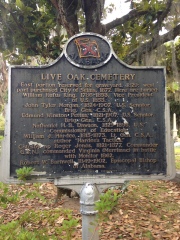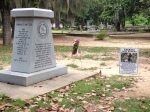By Taryn Wilson
“There is glory in graves,” reads the engraved message on the Confederate Circle Monument in Old Live Oak Cemetery. Reserved for a graveyard in 1829 and added onto in 1877, Live Oak Cemetery, now called Old Live Oak Cemetery to differentiate it from its newer counterpart New Live Oak Cemetery about a mile down the road, features two halves bisected by King Street. A busy thoroughfare connecting the Riverview Historic District to Highway 22, this section of King Street functions as a highly trafficked “cut through” of sorts for all of those who live in the neighborhoods on the other side of the cemetery. People drive and walk the 200 yard passage between the two sides of the cemetery countless times a day, finding it to be a quicker way to get to Highway 22, one of the major roadways that crisscross through Selma.
in 1877, Live Oak Cemetery, now called Old Live Oak Cemetery to differentiate it from its newer counterpart New Live Oak Cemetery about a mile down the road, features two halves bisected by King Street. A busy thoroughfare connecting the Riverview Historic District to Highway 22, this section of King Street functions as a highly trafficked “cut through” of sorts for all of those who live in the neighborhoods on the other side of the cemetery. People drive and walk the 200 yard passage between the two sides of the cemetery countless times a day, finding it to be a quicker way to get to Highway 22, one of the major roadways that crisscross through Selma.
Being in such a high traffic area, the cemetery is surprisingly quiet, with the sounds of passing cars dampened by the stone wall separating the cemetery from the highway. Cars are rarely seen parked on the gravel paths that stretch across the cemetery and, beyond an occasional runner, few living people populate the actual cemetery at any given time. With paths lined by the oak trees planted in 1879 by Col. N.H.R. Dawson, the cemetery is a peaceful albeit haunting monument to the Selma’s past. The limbs of the majestic oaks are cloaked in Spanish moss that sways eerily in the wind. And while the shaded concrete markers pay a silent homage to those who died long ago, the presence and monuments of the many deceased who call the cemetery their final resting place sends a message that is loud and clear.
Buried in the cemetery are some of the most powerful people in Alabama during the Civil War Era: John Tyler Morgan, a U.S. Senator, Brigadier General in the Confederate States Army and the Father of the Panama Canal, Edmund Winston Pettus, U.S. Senator, Brigadier General in the Confederate States Army and namesake of Selma’s famous bridge over the Alabama River, and even William Rufus King, a former vice president of the United States. The famous leaders buried in Old Live Oak Cemetery testify to the great people Selma has produced. These historic figures are laid to rest amidst the graves of countless Confederate States Army soldiers. One large statue stands out in the midst of these graves, a monument to the Confederate fallen, called the Confederate Circle Monument. Conceptualized by United Daughters of the Confederacy and financed by the families of deceased Confederate soldiers, the monument features a Confederate soldier at the top in memory of all of the soldiers lost during the Civil War.
Senator, Brigadier General in the Confederate States Army and the Father of the Panama Canal, Edmund Winston Pettus, U.S. Senator, Brigadier General in the Confederate States Army and namesake of Selma’s famous bridge over the Alabama River, and even William Rufus King, a former vice president of the United States. The famous leaders buried in Old Live Oak Cemetery testify to the great people Selma has produced. These historic figures are laid to rest amidst the graves of countless Confederate States Army soldiers. One large statue stands out in the midst of these graves, a monument to the Confederate fallen, called the Confederate Circle Monument. Conceptualized by United Daughters of the Confederacy and financed by the families of deceased Confederate soldiers, the monument features a Confederate soldier at the top in memory of all of the soldiers lost during the Civil War.
Amongst all of these peaceful markers, the one thing that makes, or used to make, the biggest controversy was a bust in remembrance of Confederate General Nathan Bedford Forrest. A known slaveholder and member of the KKK, though he renounced his membership and later spoke on behalf of racial harmony, the presence of the bust in the park became a key fighting point between two groups in the community. One side of the argument, given by Civil Rights groups, suggests that the monument glorifies a racist leader and contradicts progress made in Selma and beyond. The other side, backed by Sons of Confederate Veterans and Friends of Forrest, suggest that the bust was a tribute to a successful Confederate general who led the push to protect Selma from Union forces during the Civil War. The issue escalated to the point that the bust was stolen in March 2012 and has yet to have been found.
Confederate General Nathan Bedford Forrest. A known slaveholder and member of the KKK, though he renounced his membership and later spoke on behalf of racial harmony, the presence of the bust in the park became a key fighting point between two groups in the community. One side of the argument, given by Civil Rights groups, suggests that the monument glorifies a racist leader and contradicts progress made in Selma and beyond. The other side, backed by Sons of Confederate Veterans and Friends of Forrest, suggest that the bust was a tribute to a successful Confederate general who led the push to protect Selma from Union forces during the Civil War. The issue escalated to the point that the bust was stolen in March 2012 and has yet to have been found.
 To an outsider like myself, this kind of seems just a little bit childish, like two kids fighting over a toy. But to the people who live in Selma this is a matter of pride, even a matter of glory. Each side is fighting to protect and glorify what they believe in and those who fought for it. I don’t know that either side has a true advantage in the matter (except perhaps the individual who has the bust, of course), but I have a feeling that the city council and other local leaders are going to be mediating battles on this topic for some time to come. In a situation where opponents are at such polar opposites, I don’t know if a solution exists that would appease both sides, but I look forward to the day that a decision is made on the topic. Though Nathan Bedford Forrest is buried 305 miles away in Memphis, Tenn., a monument in Old Live Oak Cemetery now stands with a sign offering a $40,000 cash reward for the missing bust nearby. The theft from this monument can be construed as taking a bronze sculpture to prove a point, but I think of it as challenge to the inscription on the Confederate Circle Monument, an effort to take glory from the grave.
To an outsider like myself, this kind of seems just a little bit childish, like two kids fighting over a toy. But to the people who live in Selma this is a matter of pride, even a matter of glory. Each side is fighting to protect and glorify what they believe in and those who fought for it. I don’t know that either side has a true advantage in the matter (except perhaps the individual who has the bust, of course), but I have a feeling that the city council and other local leaders are going to be mediating battles on this topic for some time to come. In a situation where opponents are at such polar opposites, I don’t know if a solution exists that would appease both sides, but I look forward to the day that a decision is made on the topic. Though Nathan Bedford Forrest is buried 305 miles away in Memphis, Tenn., a monument in Old Live Oak Cemetery now stands with a sign offering a $40,000 cash reward for the missing bust nearby. The theft from this monument can be construed as taking a bronze sculpture to prove a point, but I think of it as challenge to the inscription on the Confederate Circle Monument, an effort to take glory from the grave.


